According to Coilcraft - Testing Inductors at Application Frequencies the inductance of a coil changes with frequency and current. Most datasheets don't give a frequency-inductance plot and current-inductance plot. Is there some rule/guideline to estimate the inductance at circuit frequency and circuit current given the test frequency and the max/saturation current?
Asked
Active
Viewed 252 times
1 Answers
7
In an air cored inductor this problems do not arise. It is the core material that introduces these seemingly bizarre dependencies. Take a look at 3C90 material: -

Fig1 shows how the real part of permeability peaks at a frequency of about 700kHz. In fig4 as flux density increases (caused by more current for example) the permeability also peaks up. Temperature has also an effect for many ferrites and fig2 shows how permeability is affected.
It's the core that causes these problems and the only resort is to use the manufacturer's data sheets if you can get them.
Andy aka
- 434,556
- 28
- 351
- 777
-
From what I recall, air cores too suffer the same issues, just to a much lesser degree. IIRC there was some article about this in context of the first space exploration efforts, where "precision" coreless inductors went out of measured value tolerance when exposed to a vacuum. – Anindo Ghosh Aug 01 '13 at 12:14
-
@AnindoGhosh how odd is that!! – Andy aka Aug 01 '13 at 13:10
-
Well, doesn't that make sense because instead of an air-core you have a vacuum-core? I know the permeability is only different on the order of microunits but that probably does express itself as a moving of the "knee" of frequency response. – scld Aug 01 '13 at 13:27
-
@Chris - Air has a relative permeability of 1.00000037 so no, it doesn't really make sense because the inductance change would be 0.37ppm and if used in a tuned circuit the resonant frequency would move half this amount. – Andy aka Aug 01 '13 at 15:18
-
You are correct that there is only a small difference. However, two things: First, your value for Air is certainly not some sort of scientific constant. You'll find that there are sources that quote the Er of air to be as much as 1.0006 and that's only at 1 ATM. Secondly, I guessed that they were different on an order of microunits when in fact they are different on an order of 500-600 ppm. So, a 0.5% tolerance value may see a measurable shift. – scld Aug 01 '13 at 19:44
-
1@Chris - do you have a linkable source for that knowledge. Also, you say \$\epsilon_R\$ - are you in fact mistaking Electric permittivity for magnetic permeability? Aha, just been on http://en.wikipedia.org/wiki/Relative_permittivity and yes, dear chap you are!!! – Andy aka Aug 01 '13 at 21:07